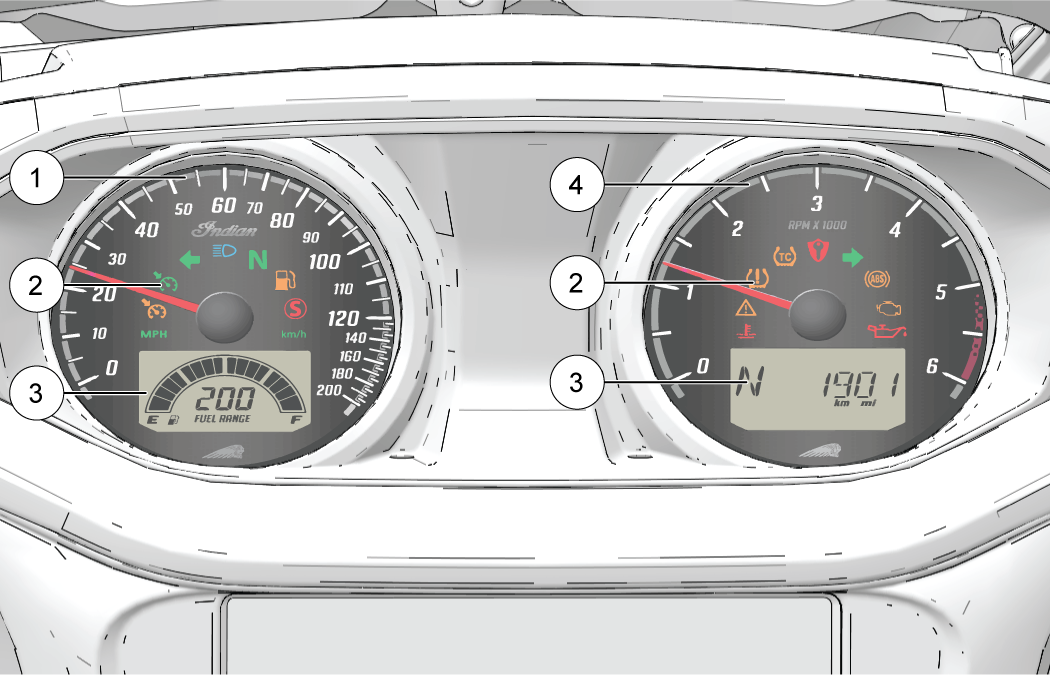
Content Source: 2021 Indian Challenger Owner’s Manual (9931587 R01) > Instruments, Features and Controls Chapter
| IMPORTANT |
|
The Owner's Manual for this vehicle contains warnings, instructions and other information you must read and fully understand before safely riding or performing maintenance on this vehicle.Always follow the warnings and instructions in Owner's Manual. Click the CONTENTS link above for the Table Of Contents, or download a full PDF of the Owner Manual in the Owner Support area of Polaris.com |

| Lamp | Indicates | Condition |
|---|---|---|
|
|
Cruise Control Status | Amber Lamp: Cruise control is enabled, but not set. When flashing, a cruise control related fault exists. Green Lamp: Cruise control is set to the desired speed. Read the safety and operation procedures before using cruise control. |
|
|
Turn Signals | One arrow flashes when the corresponding turn signal is activated. Both arrows flash when the hazard signal is activated. If there is a problem in the signal system, the lamps will flash at twice the normal rate. |
|
|
Vehicle Speed | When standard mode is selected, speed displays in miles per hour. |
|
|
When metric mode is selected, speed displays in kilometers per hour. | |
|
|
High Beam | The headlight switch is set to high beam. This indicator will flash if there is a problem with the low or high beam light. |
|
|
Neutral | The transmission is in neutral and the power switch is ON. |
|
|
Low Fuel | This lamp illuminates when approximately one gallon (3.8 liters) of fuel remains in the fuel tank. The LCD Display will switch into a Low Fuel Mileage Counter Mode to provide the rider with mileage tracking from the time the indicator was activated. |
|
|
Sidestand Light | The sidestand light will turn on anytime the sidestand is down. |
|
|
Engine Hot | This lamp illuminates to indicate an overheated engine. If the indicator flashes, a severe overheating condition exists. |
|
|
Chassis Fault | The alert symbol illuminates if a chassis fault occurs. |
|
|
Tire Pressure Monitoring System (TPMS) | The TPMS indicator illuminates if low tire pressure is detected. It will also illuminate along with the Low Battery Voltage indicator when TPMS battery power is low, requiring service. |
|
|
Traction Control | This lamp illuminates when traction control is engaged. |
|
|
Security | The security indicator illuminates when the security system is activated. |
|
|
ABS Not Activated | The indicator remains on until the anti-lock system activates, which occurs when vehicle speed exceeds 6 MPH (10 km/h). When the lamp is illuminated, the anti-lock brakes will not activate, but the conventional brake system will continue to operate normally. |
|
|
Check Engine | This lamp illuminates briefly when the power switch is turned ON. This indicates proper function. If this lamp illuminates while the engine is running, see an authorized dealer promptly. The light will remain on if the tilt sensor shuts down the engine. If abnormal sensor or engine operation is detected the light will remain on as long as the fault condition exists. Retrieve the error codes for diagnosis. |
|
|
Low Oil Pressure | This lamp illuminates when oil pressure drops below a safe operating pressure while the engine is running. If this lamp illuminates while the engine is running above idle speed, turn the engine off as soon as safely possible and check the oil level. If the oil level is correct and the lamp remains on after the engine is restarted, turn the engine off immediately. See your dealer. |

© Copyright Polaris Inc. All rights reserved.